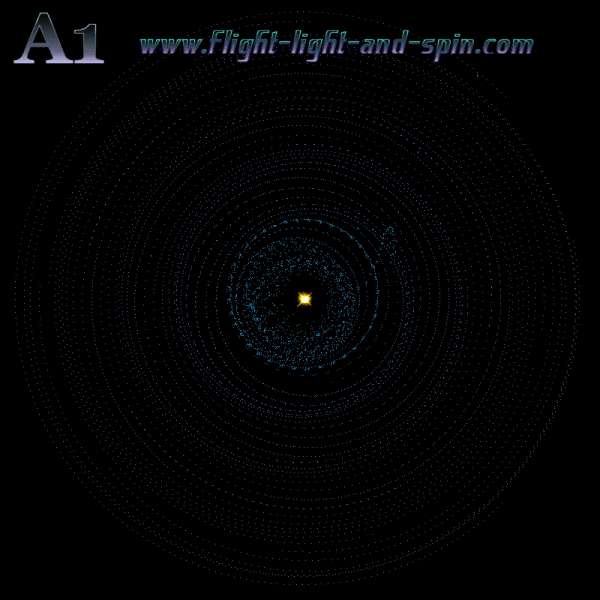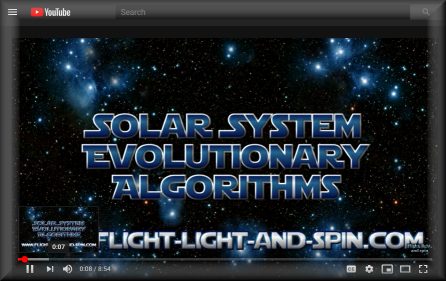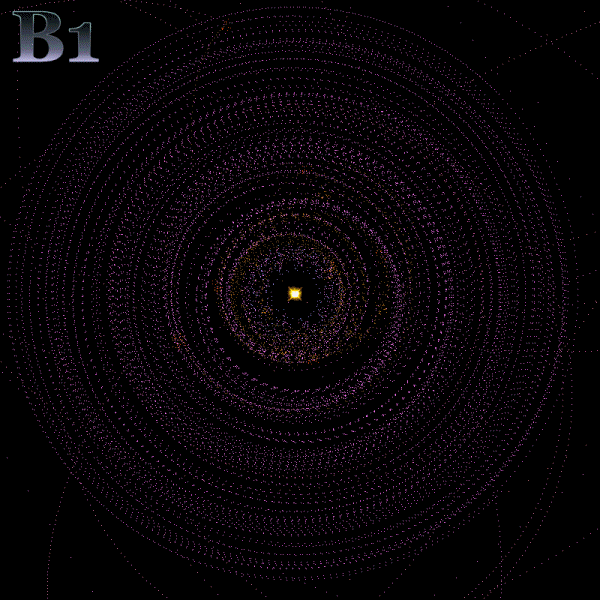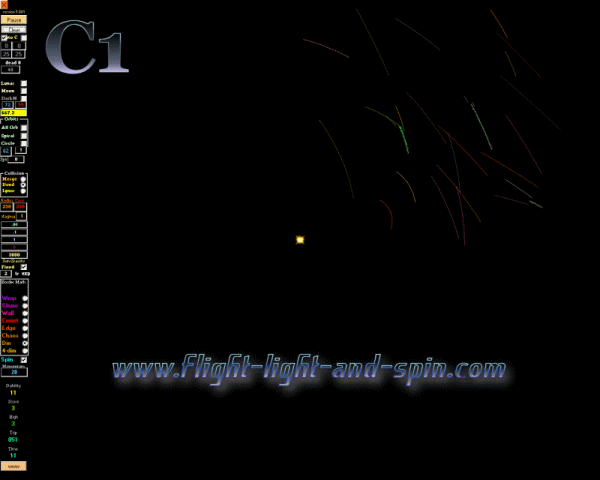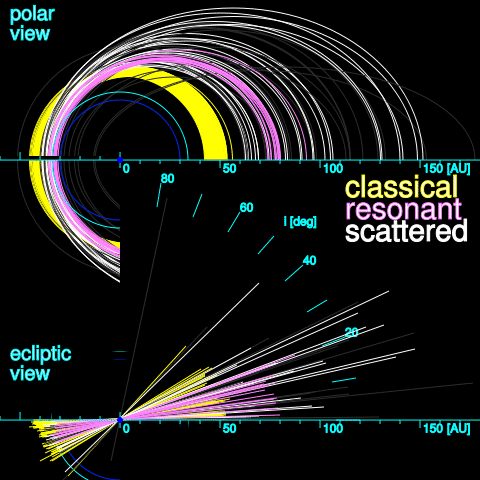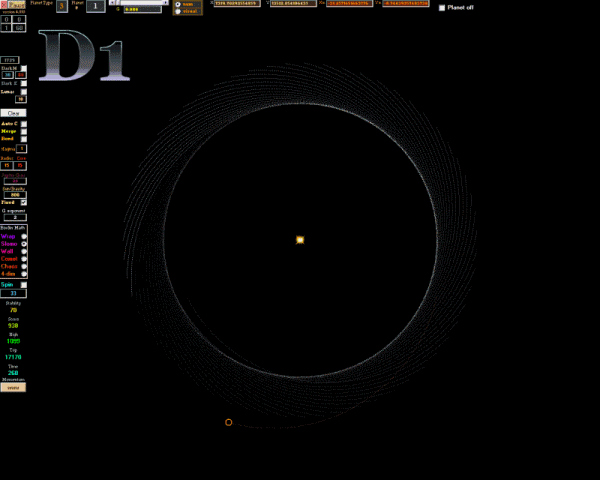| How
the Solar System Formed |
|
Solar
system A shows how planetary
orbits can coalesce from spinning debris. It’s a theory which
begs the question of how the solar system started spinning. Conservation
of angular momentum from contraction can only cause an increase in velocity,
not an actual increase in angular momentum. Angular momentum has to
be constant. |
|
Solar
System A |
A-2
shows the logical consequence of A-1. |
|
Watch the youtube videos: https://youtu.be/UexGYlOb1XI |
Solar
System B |
| In
solar system B spinning
debris is affected by random objects entering the system. |
It
is not enough to sustain a solar system at all. It soon turns to chaos even with a significant amount of starting spin. Solar system B is flawed. |
Solar
system C mimics a binary
star system where one of the stars has disintegrated. Pre-existing spin is now inherent in the orbital structure of the new planets. |
This
is remarkably similar to the existing orbital shapes within our solar
system. Such structures can only be explained by pre-existing spin. Here, the star which went nova already had an orbital structure similar to that required for a planetary system. Most of the mass from the nova is lost. But pre-existing spin is required for even a small amount of mass to retain near-circular orbits. |
The
following diagram shows the shape of orbits beyond Pluto in the Kuiper
belt. From http://en.wikipedia.org/wiki/Kuiper_belt |
Solar
System C also easily explains
why the planets are within a narrow band on the ecliptic view (side view). Binary systems must orbit each other on a flat ecliptic plane. |
Solar
System D |
| Not
only will a Solar System without pre-existing spin tend towards chaos,
but uniform solar systems become easily disrupted by one random body. |
The
above images show how easily a stable system can be disrupted with gravity being the only force to hold it together. |
Solar
system A is the generally
accepted theory, but it begs the question as to how the pre solar
system mass started spinning. |
As I write this sentence, it has been 6 years since I first built the solar system creator game (OG3) showing that spin is required to form a solar system. And yet I have persisted in trying to get solar systems to form using just gravity and randomness. Orbit Game 7 (OG7) demonstrates these attempts. If there is any possibility that such can occur I need to give it every possible chance. And I have been partially successful in getting something like a solar system to form using gravity and randomness. It required countless attempts at randomness, so that after some time, something like the parameters similar to spin accrued out of sheer luck. However, the solar systems that formed in such scenarios, overwhelmingly had planets orbiting in opposite directions to one another. Planets that orbit in the same direction spend longer in one another’s gravity field and are thus far more likely to disrupt each other’s orbits or to pull together and form a larger planet. Whereas orbits that run in opposite directions to one another are more likely to form out of randomness as they spend less time in the more powerful vicinity of one another’s gravity field. In trying to prove the Lucifer thesis wrong, further evidence accrues to prove it correct. But the implications are deeper than this, for if the many thousands of bodies documented in our solar system just happened to orbit in the same direction without a force of spin due to sheer luck, we should still have orbits that rotate vertically, (that is at a right-angle to the ecliptic plane) because these orbits are the most likely to form using randomness, instead of spin. They will interfere with each other the least; whereas a uniform solar system such as ours is by far and away the least likely to form under randomness. The very existence of the ecliptic plane should be enough evidence that spin is required to form a solar system. So this can no longer be considered as evidence for the Lucifer theory, instead the solar system creator game is outright proof of such! The Solar Systm definately formed due to the Sun's twin going nova. |
At the end of 2013, I discovered the calculations which show that when a moon is pulled away from a planet, it often drops into a lower concentric orbit around the Sun. (For more detail on this, see this link: why the moon is receding from the earth) For quite some time I had realized that the Sun was pulling the Moon away from the Earth, but it was by looking at the scenarios over and over again that I came across the parameters which showed the moon landing into a nicely near-circular inner orbit. I now reconsider this whilst constructing orbit game 7 which has more detail on solar system formation than OG3 and OG6 do. It becomes apparent why it is that the inner planets themselves resemble the make-up and mass of the moons of Jupiter. It seems that it is most likely that the inner planets were once the outermost moons of Jupiter, and that they were eventually pulled away from Jupiter by the Sun. As they interacted with the varying gravitational fields of Jupiter and the Sun, they landed in their nice balanced orbits in much the same manner as orbit game 5 demonstrates; albeit in such a way that they were not obviously recaptured. If you play around with the parameters of orbit game 5, you will find some settings which show the moon being pulled from the planet and as it heads for the Sun is still under the influence of the planet. Its velocity is held up in such a way that it ends up in that nice uniform inner orbit. Watching a small body like the moon interacting between two large ones may take some fiddling. So it is clear that most of Lucifer’s debris is swallowed by the Sun itself, but enough remains to land in these concentric orbits. It could also be that Mercury is a lost moon of Venus. And; that Venus and Earth themselves may at one point have been a binary pair. The parameters start to permeate into highly theoretical space at this time. Who knows how orbit game 700 is going to look!? But OG6 and OG7 mimic the nova of Lucifer by placing the newly formed planets in highly random fashion. They have an average spin similar to an orbit, but other than that they are randomly distributed over a wide area with randomness thrown into their respective momentums. And in these scenarios, only on a rare occasion does a lunar-like orbit form. What this suggests is that as the star goes nova, the newly formed planets are spinning with a very high angular momentum in a molten state, with spin playing a dominant role over and above the randomness of the explosion. The force of spin must have been extreme in order to force parts of the molten proto-planet to break up into the concentric patterns required to form planetary systems with the many uniform orbits of (especially) the satellites of Saturn and Jupiter. Randomness cannot account for the concentric orbits of the moons any more than it can account for the concentric orbits of the planets themselves. |
|
Latest
Article: A computational analysis of the theory of gravitational waves; as expressed within Einstein’s Theory of General Relativity and the wider realm of Astrophysics. Essentially a critique, this study has been written for the purpose of explaining the unobvious challenges faced in building graphically dynamic evolutionary computer models. These models compute the theoretical functionality of gravitational waves in the celestial paradigms of solar system formation and galaxy formation. |
| Click the link below and Download Orbit Game 6 (2014) to see the real-time computations. Version 6 has fixed planetary sizes. >> orbit-game-6.exe << 276 kb . |
If your PC is
set to use the comma as a decimal separator,
then these apps won't work so good.
|
|
< top >
< seti >
< why? >
< credits >
< gravity >
< contact >
< dark matter >
< dark energy >
< binary orbits >
< the big unwind >
< force of gravity >
< zeno and planck >
< quantum gravity >
< bin laden helicopter crash >
< how the solar system formed >
< gravitational waves & general relativity >
< why the moon is receding from the earth >
< why the moon is red during the lunar eclipse >
< summary of rotation curves of spiral galaxies >
< rubin's problem - rotation curves of galaxies - rubin's problem animated >
